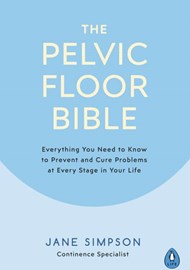Jane Simpson’s aim with this book is to “start a pelvic floor revolution”. She covers all the basics in this succinct book and gives us an insight into the many patients she has treated in her long career as a continence specialist. The book is aimed at both men and women and covers the basic anatomy, urinary systems and the history of pelvic floor exercises.
There is a clear account of how to do a pelvic floor contraction for both men and women and a brief introduction to apps, electrotherapy and biofeedback gadgets. Stress and urge incontinence are described and the taboos which prevent help seeking explored.
Chapter Five is about prolapse and all the basic information about causes, symptoms and treatment options are there. The author mentions the French system of postnatal rehabilitation several times and reminds us of the importance of pelvic floor exercises in pregnancy and postnatal recovery in Chapter Six. Chapter Seven focuses on the menopause and gives a brief but clear overview of menopausal symptoms, the use of localised oestrogen and hormone replacement therapy (HRT). Sex is examined in Chapter Eight with an explanation of the vulva, female reproductive system and normal female sexual response are. Male sexual dysfunction is described and there is a paragraph on sensate focus with the recommendation that these issues are dealt with by a clinician. Bowel health is the subject of Chapter Nine, with a long section on constipation and self-management. There are brief descriptions of bowel disorders and faecal incontinence with conservative and surgical solutions. Issues which are specific to men are in Chapter Ten, with the various causes of incontinence, prostate health and appropriate interventions all mentioned.
There is a brief glossary of terms and a comprehensive list of resources for further help. Signposting is important as a short book can only ever touch the surface of the complex health conditions Jane Simpson explores. There are multiple quotes from the author’s patients expressing their gratitude for her intervention which will, I hope, encourage readers to also seek help.
This is a short book which is a good overview of pelvic health. There are not many illustrations but the language is clear and will be sufficient for most patients. It would be a reasonable starting point for patient education or for people with a new interest in pelvic health.





